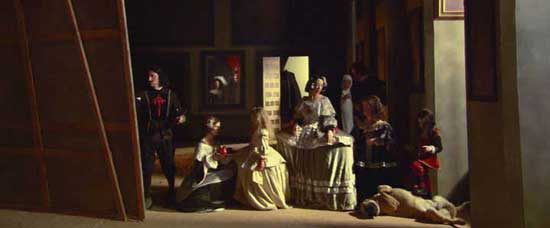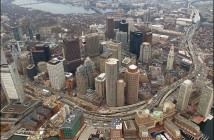Video is the language of our culture. Video images signal to us a technological present that reveals without reflection, and can only be witnessed as it continues to present itself in an ever-flowing extreme of collective consciousness.
We presume it to represent the ‘real’, even the ‘Real’ as in Reality Television (the extreme behaviors of people under stress). We look to the medium to put us in touch with unplanned events, where anything can happen and we are privileged to be witnesses. But even as we seek the thrill of this ‘real’, we are all too aware and even expectant of the artifice that frames our reality.
When it becomes high art (e.g. Eve Sussman’s “89 Seconds at Alcazar”, presented in the most recent Whitney Biennial) it loses its quotient of presence and becomes spectacle. It takes on the conceptual conceit of the analytic as well as exploiting the aesthetic of its technological apparatus.
In this work, a tableau vivant based on Velasquez’ “Las Meninas”, Sussman orchestrates a choreography of revealing. The mysterious play of illusions operative in the painting are opened up into a ‘mes en scene’ which explores various fictional relationships within the court/artist’s studio. What was once a work filled with devices designed to entrap the viewer in a web of illusions and visual tricks, becomes a soap opera of impeccable likenesses. The scale of the projected image is spectacular (c. 20’x15’), its High Definition resolution is hyper-real, and its art direction as a copy of the painting’s tones and light, is nearly flawless. The animation of these historical images liberates them from the control of the painter and of history. The characters take on the verisimilitude familiar in docudramas. We understand that they are not the historical figures they represent, but we suspend judgment in order to experience vicariously the intimacy of their interactions.
The narrative of the video loop is executed brilliantly with the surprise visit of the King and Queen who are otherwise only represented (in the painting) within the frame of a mirror image of the painting-within-the-painting.
If we consider this work in psychological terms, it serves the return of a repressed desire, that of the return of a monarchy. The video uses the ‘old order’ to explore the fantasy of hegemonic power where the elevated technology itself presents the model of a world domination. The Museum becomes the court, the art patron, a courtier (mirrored in the shadowy figure in the doorway), and the tourists/pilgrims, the ‘people’ who are ruled (the viewers). Here we have the pure ‘aestheticizing of the political’. When video is used in the service of ideologies or the clash of cultures, it becomes propaganda or symbolic warfare.
The Nicholas Berg beheading tape purports to reveal an intrusion of the Real (the rupture of the Symbolic norm). We are not, as a viewing public, given the brutal totality of the piece by our media, only the initial staging of the event. We see the ‘terrorists’, hooded executioners, lined up as on a stage. Berg is seated on the floor in front of them, wearing an orange jumpsuit. These images act as a mirror of our own treatment of prisoners at Abu Ghraib and Guantanamo prisons. The central figure reads awkwardly but emphatically from a scripted document in Arabic. He shuffles the papers, losing his place but never the constant flow of his diatribe. This is where our official media coverage ends. But the tape continues (as viewed by this writer on the internet). The central figure folds the paper and tucks it in his shirt, from which he draws a large knife. As he does this one hears a piecing scream. It is not Berg, it is someone outside the frame, perhaps a woman. He grabs Berg by the hair, pushes him on his side onto the floor (facing the camera). Berg calls out loudly as the knife slides across his neck. Guttural sounds can be heard, and then something unusual happens. Up to this point the camera has been still, immobile on a tripod. Suddenly there is a flurry of movement, zoom in, confusion in the shot. It finally settles on Berg’s upper body, and we witness the struggle to move the blade through the resistant flesh. This is a dull blade. Upon completion, the executioner lifts the severed head high holding it still by the hair. We recognize Berg, his beard, his features, but it is unbelievable, and seems like a reenactment of the slaying of John the Baptist. The last image is of Berg’s head resting on the back of the body, the job done!
The puzzling thing about this tape is the degree to which it fails to communicate the brutal physical reality of the event. It becomes like any other extreme image seen on television or movies. It is a snuff film. Someone has been murdered for the sake of the image. The production of this scene is for the impact it may have on viewers who understand the signs. ‘You think you are above these things, but you have done nearly the same things to our people. We are showing you that we understand completely what lies just below the surface of your civilized codes. Do not turn away, but learn about yourselves. We will continue to break into your Symbolic order with our Real.’
And where is the Imaginary? We are brought to the Bible, our ancient roots. The tale of martyrdom for the sake of the refusal of a seduction. Who is the exotic Other in the seven veils? What is the temptation? Oil? Empire? Global capitalism? We are flooded with a parade of religious imagery, the tribal strife that fills the Old Testament, as well as the current references by our leaders to a ‘crusade’ and this noble cause to bring ‘civilization’ to the barbarians. Ironically, of course, the images to which this piece is a response, complicate the binary of our ‘good’ and their ‘evil’, as we are faced with our own ‘frat boy’ version of brutality.
This grimy, low-tech video, with its compressed approximations of the site of the action, is the supreme illusion. It demands an accounting of our expectations of representation. What does it take for us to believe? How do we know that this is an actuality? I don’t doubt that it happened, and that it was meant for me. But what do I know and how do I know it?
If this piece, and the whole project-of-the-Other (terrorists) opens up a previously foreclosed social possibility, then we are dealing with the return of a repressed tribalism, characterized by extreme brutality, vengeance and boldly symbolic rhetoric. Ours is a ‘rational’ society, based in the Law, having transcended the past of the arbitrary actions of a power elite (monarchy, church, despot). What has been repressed is not far below the surface (we are reminded when we note the number of violent crimes we suffer, as well as the revelations from within America’s military prisons). But these cases are characterized as exceptions to the rule of Law that keeps us civilized, and are adjudicated within the legal and penal system (in fact, the site of many injustices).
The Stage: in fact both of these videos are staged; one, on the world stage of art, the other on the world stage of the political. Both are concerned with the organization and wielding of power. It seems, however, that the real power in both cases is the camera and it’s capacity to frame what are otherwise fairly unstable events.
The Spanish court is opened up to a play of intrigues, which could at any time serve to disrupt the status quo of rule. One senses the machinations of the characters as portent of future eruptions or revolutions. If we think ahead in the history of Europe, we remember the reversals suffered by monarchs, leading to what we now know as ‘democratic’ states.
But beyond the art historical, what is being celebrated here is the staging of the medium itself. The artist and the institution have brought the medium to its most immodest elevation yet. Throughout the Whitney Biennial, huge video images dominate the objects around them. The stage of video as the primary medium of representation has been set.
This complicates our notions of the ‘real’ of the medium, and causes us to withdraw from the lingering ‘aura’ of veracity that has characterized the ‘good’ of video (as TV) versus the ‘bad’ of its ‘scale and resolution’ differences from film.
In the case of the Berg video, we see the formal ritual of revolutionaries and their committed challenge to the status quo ante of Western democracy. There is no vain affect here, but only the directly crude performance of a theater of cruelty. This is the Batiallian excess brought to embodiment. One has to pause, however, at the moment of the ‘scream’, the voice heard off camera, and the subsequent shift of POV to that of the camera operator, who seems to be caught off guard by the sudden appearance of the knife. Was all of this intended, or did an hysterical frenzy break through the ‘planned event’ (perhaps more a threat) to transgress the limits of the stage? . So we need to look at this piece as a theatrical metaphor brought to us through access to the technological invention that crowns our cultural hegemony. As in the case of 9/11, the perpetrators have turned our ‘benign’ technologies into weapons against us.
In both cases, the frame of history has been penetrated.
Images used courtesy of the artist.
Jane Hudson is an artist, professor and musician, as well as an occasional contributor to Big, Red & Shiny.




